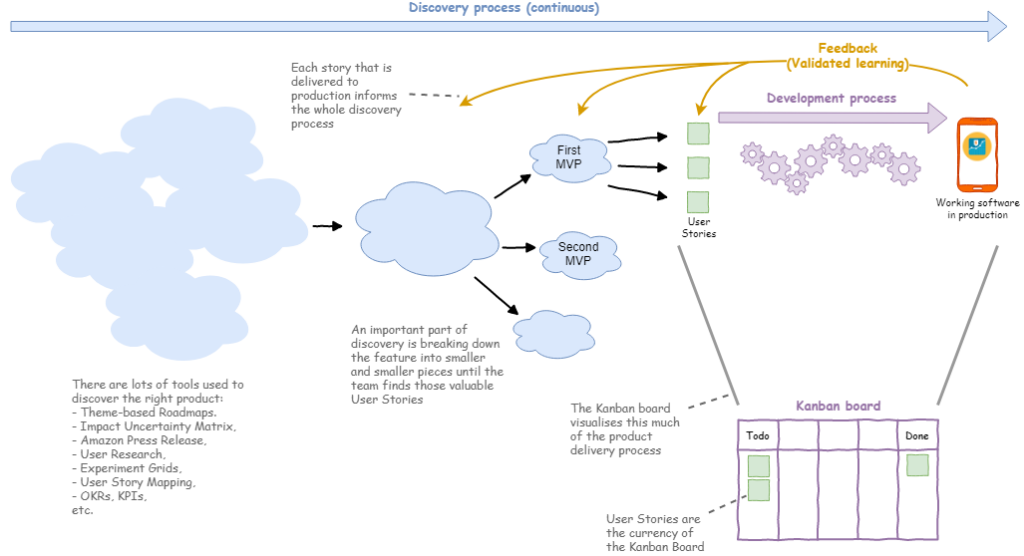When adopting an Agile development process, the team should start with visualising their work using a Kanban board. At the start, the items on the board will probably cover a whole range of work including hopefully a few User Stories. What can happen then is that if the team uses these items to try to create flow they will probably end up trying to model their entire development process (from idea to product) on the Kanban board, or worse still, try to apply Sprint planning to it.
This is especially true for platform teams that move to become cross-functional teams. The problem is that a Kanban board can only really handle the flow of one type of object (i.e. model one process) and that object has to have a clear “Definition of Done”. But hey, the whole point of using Kanban is to visualise the work so the team can do something about it to improve flow.
As I said, the Kanban board works best if you supply it with right-sized work items, and in software development these items are usually User Stories. But using Kanban to manage the flow of User Stories is only going to capture one part of the work that the team do to deliver the right thing to customers. The other part is the preparation of these valuable right-sized User Stories and their acceptance criteria, what is known as the Product Discovery process. Product Discovery and Product Development form a highly integrated dual-track development process.
Product Discovery follows a different process to User Stories: ideas are being analysed and discarded or morphing into something else. (It is a fluid process, but Kanban can still be used even here to visualise it). So even though the team could be spending 50% of their time breaking down the problem, defining an MVP and creating good User Stories, this effort will not be visible on the User Story Kanban board. Or more accurately, the time spent is not part of the User Story lifecycle, since the story can’t start its journey across the Kanban board until the discovery process is complete.
This is not to say that the team cannot visualise discovery work, it just means that it cannot be attached to any particular User Story. Instead the team can represent it using another object: the Task. Unlike Stories, Tasks do not deliver customer value. Tasks could cover any kind of activity: a spike, an analysis, purchasing a license, setting up an environment, etc. Even if there is no customer value involved, the team should still strive to create well-defined or time-boxed tasks: what is the spike attempting to prove? When is the setup complete? In other words, Tasks must also have a clear “Definition of Done”.
While the Kanban board can be used to track Tasks, the team should only use it for well-defined tasks. Activities like meetings and discovery sessions form part of the team’s work that should not be quantified using Kanban. After all, the goal is to deliver valuable right-sized User Stories to the customer, not to document the completion of Tasks.
Lastly, the team can benefit from being able to visualise which User Stories belong to which MVP. In Jira (for example) the team can group related User Stories using the Epic Issue Type. Thus, an Epic can be used to represent an MVP. If the team want to track activities related to breaking down the MVP, then they can also be associated with the Epic. Finally, the team can also create a separate Epic Kanban Board which track the flow of Epics: they are bigger objects that move more slowly but should still have a clear Definition of Done.

